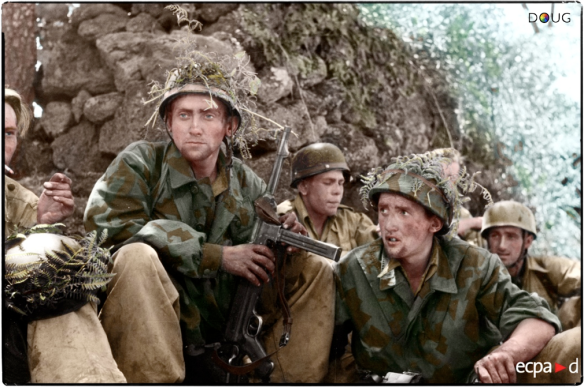A German Fallschirmjäger Regiment in Sicily August 1943.
Oberstleutnant Heilmann in Sicily.
It was not until noon on 11 July that Student received orders to move the 1. Fallschirmjäger-Division to Italy that afternoon. Generalleutnant Richard Heidrich, the division commander, flew with his battle staff to the headquarters of the Commander-in-Chief South at Frascati, near Rome.
A short while later, Oberstleutnant Heilmann’s FJR 3 started out from Avignon and Tarascon for Italy. The second lift consisted of the airborne machine-gun battalion and the division’s airborne engineers. The third lift was Oberst Walther’s FJR 4 and the division’s antitank battalion. The final lift was composed of FJR 1 and the airborne artillery battalion.
When FJR 3 approached the airfield at Rome to land, Generalleutnant Heidrich was already there. He greeted Oberst Heilmann with a powerful hand shake: “Good to see you, Heilmann. Despite the delay, I still think it’s possible to throw the enemy back into the sea.”
Heidrich then turned to the commander of the signals company, who had just landed with his men, and briefed him on the necessity of establishing a command and control apparatus on Sicily in the shortest time possible.
On the morning of 12 July, as the paratroopers of FJR 3 were in the process of loading their weapons and equipment on the He 111’s, an advance party was already flying to the island. It consisted of Hauptmann Stangenberg, an officer on the divisional staff, Oberst i.G. Beelitz, the operations officer at the headquarters of the Commander-in-Chief South, and Hauptmann Specht, the division’s logistics officer.
While that He 111 flew directly to Sicily, the He 111’s of the paratroopers had to make an intermediate stop at Pompligiano near Naples for refueling. The refueling mission there was not without its problems. The day before, the airfield had been bombed and transformed into a wasteland. The refueling was delayed by hours and the regiment was unable to continue its flight to Sicily until the afternoon.
It was exactly 1815 hours, when the first jump horns sounded in the aircraft. Oberstleutnant Heilmann leapt out of the aircraft with determination and soon more than 1,400 parachutes could be seen deployed over the broad wheat fields at Catania. The regiment landed without enemy interference to the south of a line running from Stazione di Passo to Martino. Due to the heavy breeze that was blowing, there were some jump injuries. The regiment was able to jump so close together that Heilmann was able to assemble his regiment in the space of 45 minutes.
Heilmann ordered his men to head south to link up with the vehicles that were waiting for them.
They marched in the direction of Lentini and established contact there at 2000 hours with Kampfgruppe Schmalz of the “Hermann Göring” Division. Oberst Schmalz briefed the senior commanders of the paratroopers on the situation. That night, Heilmann had his men take up positions in a line running between Carlentini and the Mediterranean. The II./FJR 3 was sent by Heilmann to Francofonte, where it was to close the gap between Kampfgruppe Schmalz and its parent division.
While all that was happening, the situation on the island had reached crisis proportions.
While the defensive fighting was raging in the sector of the three paratrooper battalions that had been inserted and Kampfgruppe Schmalz, the airborne division’s machine-gun battalion had landed at Catania during the afternoon of 13 July. Major Schmid, the commander, immediately went to Schmalz’s command post. At the same time, Hauptmann Laun led the battalion towards Primasole, where it rested in an orange tree orchard, taking up concealed positions from the air.
Also landing at the airfield at Catania was the division’s antitank battalion. Two of the aircraft that had just landed fell victim to a bombing run by Flying Fortresses. The Gigant transporters were destroyed, along with all of the equipment and weapons they had on board, decisively weakening the division’s antitank forces.
The division’s signals company, under the command of Oberleutnant Fassel, was dispatched to safeguard Catania’s harbor as soon as it landed, since the Italian garrison had disappeared.
